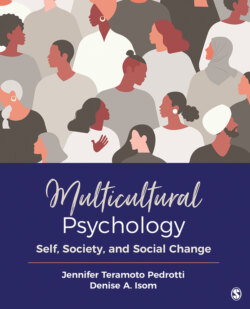Читать книгу Multicultural Psychology - Jennifer T. Pedrotti - Страница 54
На сайте Литреса книга снята с продажи.
Models of Worldview and Values Kluckhohn and Strodtbeck’s Value Orientation Model
ОглавлениеOne of the best known models of worldview is that of Kluckhohn and Strodtbeck (1961), which includes descriptions of several different value orientations that may impact the way in which one sees the world. As we have already noted, different cultural groups often have different orientations, and those endorsed by the group explain the dimensions that a particular culture finds beneficial and positive (Carter, 1991). Kluckhohn and Strodtbeck distinguished five main dimensions and asked the question “How might different groups respond to these different dimensions?” Each dimension and its range of variations are listed in Table 3.3.
Table 3.3
Source: Adapted from Kluckhohn, F. R., & Strodtbeck, F. I. (1961). Variations in value orientations. Evanston, IL: Row, Patterson, & Co.
The first dimension described by Kluckhohn and Strodtbeck (1961) has to do with human nature. The researchers give options of evil, neutral (mixture of good and evil), and good for this particular dimension; these refer to one’s inherent nature (Zaharna, 2000). For this orientation only, there are also qualifiers given to the variations; Kluckhohn and Strodtbeck note that some groups may allow for this dimension to be mutable (i.e., a group belief that human nature can change) while others view it as immutable (i.e., the belief that human nature is set, and thus unchangeable). Dimensions 2 through 5 do not have such qualifiers.
The second orientation is listed by Kluckhohn and Strodtbeck (1961) as man-nature, though more recent authors have changed this title to person-nature to be more gender inclusive (Mio, Barker, & Domenech-Rodriguez, 2015). This dimension describes the relationship groups of people might have with nature in terms of their tendency to live in harmony with nature, or to have a relationship that dictates either person or nature as dominant.
The third orientation, time, refers to the orientation a particular group may have with the past, present, and future. The United States, for example, is very future oriented. If you are a student in college right now, you probably get many more questions about what you will be doing with your degree, than what you are doing right now.
The fourth orientation, activity, describes the value one has for different types of activity and lists the variations being, being-in-becoming, and doing. These variations are less self-explanatory, and so we will delve into their meanings a bit more here. Groups who value being believe that what one is currently doing is the positive state and might involve less focus on self-development or change. Being-in-becoming instead emphasizes the value of “working on” oneself from where one currently is and striving toward self-development, while doing is more self-explanatory in that groups that value this appreciate what someone does more than who the person is.
Finally, the fifth orientation described by Kluckhohn and Strodtbeck (1961) is relational and focuses on the types of interpersonal dynamics that are valued by different groups. For some that relationship is valued most if it is linear, meaning that a hierarchy involving a wide social circle (including family, friends, leaders of the community, etc.) is valued most, and groups that have this orientation may also have specific rules in terms of how to interact with others. Collateral relationships involve those that value input and respect for family members, often including extended family and friends, while groups that value individualism emphasize the individual person in making decisions and in determining how one interacts with others (Carter, 1991; Kluckhohn & Strodtbeck, 1961; Zaharna, 2000).
The values such as those described above greatly influence worldview and thus many have made efforts to categorize various groups on Kluckhohn and Strodtbeck’s (1961) dimensions. Some distinctions have been found with regard to cultures that embrace more individualist ideals in comparison to those that are more collectivist in orientation. Cheung, Maio, Rees, Kamble, and Mane (2016) conducted a study in which they investigated the connection between individuals and their culture’s values in participants from Britain and the United States (individualist nations), and compared these connections with those of participants from India (a collectivist nation). In this study it was found that individualist nations have stronger connections to the value orientations that refer to self as opposed to community. Specifically, participants from these countries valued their own personal values (which may also be tied to their cultural values, but did not have to be) more than those that they understood they were “supposed to” value based on their culture. The opposite was true for the participants from India, with results showing a strong value for those values set forth by their culture as things they should do and value (Cheung et al., 2016). This provides evidence for the notion that collectivist cultures ask individuals to assimilate (i.e., adhere closely to cultural norms) more often than those in individualist cultures.
Other studies have linked Kluckhohn and Strodtbeck’s (1961) framework to particular cultural groups. See Table 3.4 for Ho’s (1987) helpful description of five different cultural groups and their value orientations based on common cultural norms for each group. Note that there are many similarities among Asian Americans, American Indians, African Americans, and Latinx Americans in many of the different value orientations, though some variations are noted. These similarities are in contrast to what is valued as a norm among middle-class White Americans in most cases (Ho, 1987; Sue & Sue, 2016). This type of multicultural comparison is important and may explain some tensions in communication and other factors between racial and ethnic majority and minority cultures.
Table 3.4
Source: Ho, M. K. (1987). Family therapy with ethnic minorities. Newbury Park, CA: SAGE.
